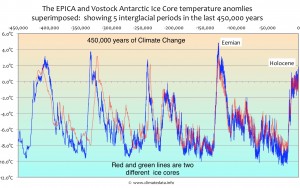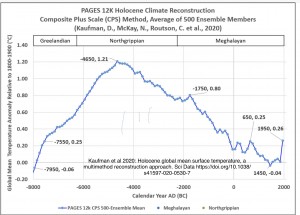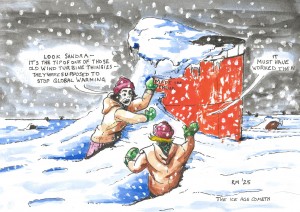The Ice Age Cometh – climate change explained in three graphs [1]
So, geologists observe, a cycle
Hath smaller cycles that on them prey
And these have yet smaller ones to bite ‘em
And so proceed ad infinitem
Thus, every Era in its kind
Repeats all those that come behind
RM (with acknowledgment to Jonathon Swift, 1733)
Summary
In the Earth’s 4600 billion years history, we have good evidence for five Ice Ages, but, as they are hard to define in the older rocks, there were probably more. Each Ice Age lasted around 20-50 million years. What caused these Ice Ages? It may be variations in the output of the sun, it may be galactic scale variations of the Cosmic Ray Flux, it may be changes in the distribution of land and sea caused by Plate Tectonics: but the short answer is, we just don’t know.
The last Ice Age, called the Pleistocene Epoch, began 2.5 million years ago. We live in a brief period of relative warmth (an interglacial) within the Pleistocene known as the Holocene which began 11,000 years ago. The Holocene itself is merely the last of a series (at least 40) 10-15000 years-long interglacials within Pleistocene. Nothing is surer in science than that the glaciers will return. In fact, they are overdue.
When the ice returns, we will probably survive as a species, but our civilisation may not.
The Big Picture
At the most fundamental level, Earth’s history is divided into four vast periods of time called Eons. Using geologist’s shorthand, where Ka is one thousand years: Ma is 1 million years and Ga is 1 billion years, they are:
the PHANEROZOIC (0 to 543Ma); the PROTEROZOIC (543Ma-2.5Ga); the ARCHAEAN (2.5Ga-4Ga) and the HADEAN (4Ga-4.6Ga).
With our short life spans and even shorter memories we have trouble comprehending these gulfs of time. This can lead us to overestimate the significance of the age in which we live. It is a form of hubris.
It may help to realize that, on comparative geological/human time scales, the Hadean commenced 20 years ago and the Phanerozoic 6 months ago. Eight days ago, towards the end of the Phanerozoic, dinosaurs roamed the land, sea and air and appeared masters of their universe (then the meteor struck). An Ice Age called the Quaternary began around 20 hours ago. Five minutes ago, during a brief period of ice retreat in the Quaternary called the Holocene, our turbocharged civilisation took off and thrived. A lifetime of human experience is gone in less than a second.
Such a timetable should teach us humility.
543 million years (543Ma) of Climate Change
An Ice Age is a significant (i.e. millions of years) period of time when permanent ice exists at the poles. Thes Ice Ages lasted between 20 and 50 million years and, between them, make up around 4% of geological time. There is a suggestion that the frequency of Ice Ages is increasing over time, but this may just reflect the fact that these things are more readily identified in younger formations.
Three Ice Ages occurred in the 540 million years – Phanerozoic Eon. General warmth (much higher than today), along with high levels of oxygen and CO2 (also much higher than today) in the atmosphere, drove the evolution of complex multicellular life forms enabling it to colonize the land.
Figure 1: 543Ma (million years) of Climate Change. The horizontal axis shows millions of years before present. On the vertical axis, temperatures are estimated from rock proxies. Average temperature during these 540Ma was 20°C, but range from 28° to minus 12° (In 2016 it was 14°). PETM=Paleocene-Eocene Thermal Maximum (55.8Ma); EEOC=Early Eocene Climate Optimum (42Ma); MECO=Mid-Eocene Climate Optimum (15-30Ma); EOT=Eocene-Oligocene Transition (40-33Ma); MMCO=Mid-Miocene Climate Optimum (15-13Ma); LGM-Last Glacial Maximum (21Ka); PAW= Post-Anthropogenic Warming (a projected future temperature from IPCC worst-case computer models). White stars indicate rapid cooling events: black stars rapid warming events. Reference: Christopher R Scotese, 2016 (Northwestern University) – Phanerozoic Temperature Curve. Palaeomap Project, Evanston II.
Homo Sapiens evolved during the last of these Ice Ages, a Period known as the Quaternary. It began 2.6 million years ago following 60 million years of slow cooling from the Late Cretaceous hothouse conditions. We do not know how long the Quaternary Ice Age will last. We live within it and the evidence of previous multiple advances of the Pleistocene Ice Age suggest it still has many tens of millions of years to go.
540 thousand years (540Ka) of Climate Change
During the Quaternary, glaciers advanced south and north from the poles, covering land and sea in kilometer-thick ice, sculpting the earth beneath. Sea levels rose and fell by more than 100 meters. Some species became extinct, new ones evolved; most were widely redistributed.
If we bore down into the Quaternary, we see a pattern of repeated advances and retreats of the ice: 100-150 thousand years of advance followed by 10–15-thousand-year intervals of retreat and moderately-warm weather. We call these brief intervals Interglacials. Throughout the Quaternary there were dozens of these glacial/interglacial cycles. The cycles are called Dansgaard-Oeschger Events (after two awkwardly named Danes). It is widely accepted that D-O Events were caused by the near-metronomic beat of wobbles in the tilt of the Earth’s axis and variations of its orbit around the sun (the Milankovitch Cycles).
We live in a Quaternary Interglacial called the Holocene. The previous Interglacial is called the Eemian. The deep trough in temperatures between the Eemian and the Holocene is known as the Last Glacial Maximum (LGM) which reached its nadir 21 thousand years ago (21Ka). The LGM was the coldest period of the Quaternary so far, but it would be naive to conclude that the succeeding warmth of the Holocene marks the end of the Quaternary Ice Age. The Holocene is merely the latest in a cycle of all too brief interglacials and has no particular geological significance. We just happen to be living in it.
Figure 2: This chart shows temperatures during the last 20% of the Quaternary Ice Age (the graph covers a period from 540 thousand years ago to present). It is based on deep ice cores from Antarctica. As ice accumulated over time through surface snow fall, the ratios of oxygen isotopes in the entrained air provide a continuous detailed record of ancient atmospheric temperature. Ice cores from Antarctica provide our longest and best calibrated record but the temperatures recorded are consistent with results from other proxies from around the globe. Reference www.climatedata.com
During the Eemian Interglacial (which was warmer than today) hippopotami gamboled in the River Thames. 100,000 years later, with the arrival of the Holocene, human civilisation took off, and large mammals gamboled once again on the Thames.
10 thousand years (10Ka) of Climate Change
As you can see from figure 2, all the Interglacial events of the Quaternary followed the same pattern – a rapid 8°-10°C rise in air temperature over a just a few decades, followed by a slow fall over the succeeding millennia. The relentless fall of temperatures from the Holocene Climate Optimum of 8-4000 years ago (figure 3) matches this pattern and is an ominous pointer to what is in store for us.
Figure 3: A compilation of global average surface temperature over the past 10,000 years. Based on different types of proxy data from around the globe. Note the gradual decline of temperatures from the Holocene Climate Optimum of 8-4000 years ago, the minor temperature peaks of the Minoan, Roman, Early Medieval and Modern Warm Periods, and the deep trough of the Little Ice Age. Nature Sci Data 7, 201 (2020). https://doi.org/10.1038/s41597-020-0530-7
There is nothing surer in science than that the ice will return. In fact, it is overdue.
Will we survive the next ice advance?
The Modern warming trend (which began in 1976 – a microsecond ago) gives faint hope of a delay in the inexorable return of the ice. But when it does return in 100-, 500- or 1000-years’ time, as a species we will surely survive. After all, with lesser technology, we survived the last advance of the ice. But will our civilisation?
Our few descendants (as they trudge through the snow in their furs) will look back with puzzlement on the Global Warming concerns of their 21st Century ancestors.
[1] The average temperature of the lower atmosphere – the troposphere, where all weather is generated – is the most fundamental single measure of global climate. The three graphs I present seek to show the change in tropospheric temperature over increasingly longer periods of geological time as we look back from the present day. The graphs summarize our best data I can locate, but their detail will inevitably be modified as knowledge advances. It should be noted that these global trends may be amplified or smoothed by regional factors.
Click for higher resolution, larger images.


